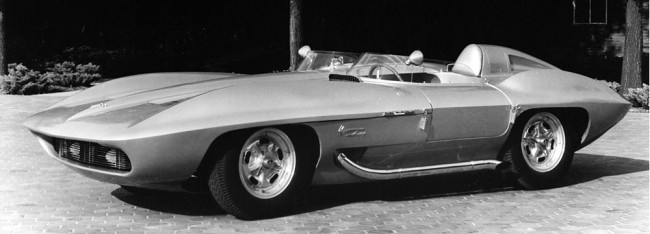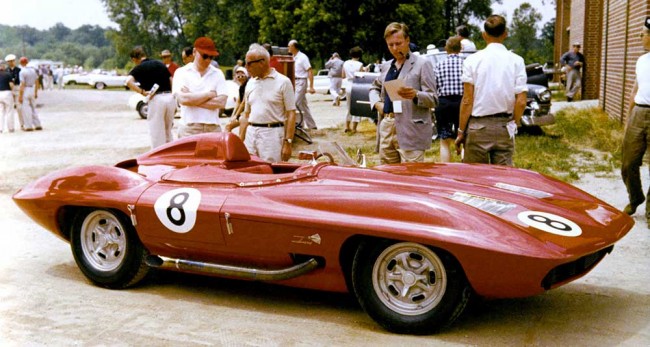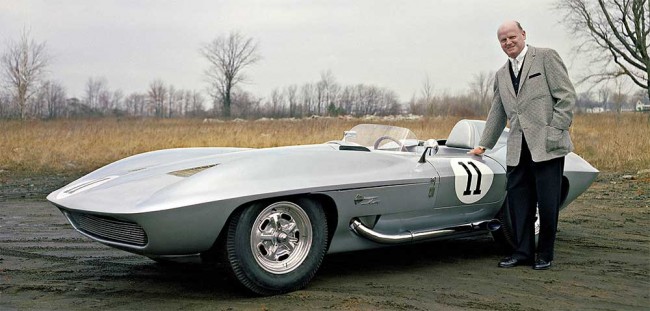Contributed by Martyn Schorr
Motor Trend, April 2014:
In the September 2013 issue of Motor Trend, we ran a timeline showing the history of the Stingray (Refined Tuning, page 44). We later received a letter from Martyn Schorr, automotive journalist, PR man, author, historian, and founder of Vette magazine letting us know Bill Mitchell’s 1959 race car, the XP87, should’ve been spelled “Sting ray,” two words, not Stingray.” We printed it in the December 2013 issue (Your Say…Stingray vs. Sting Ray vs Sting ray: The Name Game!, page 44) along with a response from the GM Heritage Center’s Christo Datini, but his explanation didn’t satisfy Schorr. He took it upon himself to set the story straight. Here’s what he found.—Scott Evans
“Everybody is confused and have been for a long time.” And, Christo Datini goes on to talk about ‘confusion,’ but never really explains what caused it. It was a helluva lot more than simply writers and marketers misusing the word(s).
After reading GM Heritage Center archivist Christo Datini’s response to my Sting Ray vs. Stingray “badging” of Bill Mitchell’s ’59 Racer, I was unfortunately still confused.
When Mitchell’s Racer was initially styled and built in 1958–1959, it was a red, single-seat racecar, built in-house and owned and financed by Mitchell. It was badged, “Stingray.” There was no Corvette ID on the car. It later came back to Mitchell, was fitted with two seats and some amenities and painted silver. Badging remained “Stingray.”
As GM Design and Chevrolet were in the process of finalizing the design of the 1963 Corvette Sting Ray, heavily influenced by Mitchell’s Racer, GM purchased the Concept and rebadged it with ’63 Corvette and Sting Ray emblems. And, someone in Design, possibly in the Graphics Dept., cut or split the Stingray side script into two pieces, retaining the cap S and lower-case r.

Hey presto. Now it’s Sting ray. Who knows how that happened. To separate the word was a deliberate decision approved by a studio head or above. I suspect that the original emblem was modified because I just can’t believe that Graphics Studio would have allowed the R to be lower case if Stingray were split. The problem with Pete Brock’s explanation is that the emblem on the production C2 Corvette read StingRay, not Sting ray.—Gary
“The Corvette and Sting Ray emblems were added to Mitchell’s ex-racecar and the Stingray script emblems on the sides of the fenders were cut and split into two pieces, Sting ray for the showing of the 1963 Corvette Sting Ray in the Fall of 1962 at Riverside Raceway,” said Peter Brock who was intimately involved in its design while he was at GM Design, 1956–1958. He is also author of the award winning, Corvette Sting Ray, Genesis of an American Icon with Mitchell’s ’59 Racer on its jacket and Foreword written by Ed Welburn, VP of Global Design, GM. It is an impressive tome that takes you inside studios never open to the public.
Mitchell’s Racer was then officially known as the XP87-CORVETTE STING RAY. And that’s the way it was featured on a full page in a GM/Chevrolet brochure, XP CHEVROLET EXPERIMENTAL VEHICLES, distributed to the media and available at some auto shows.
That may actually explain where my “confusion” came from. I was Editor of CARS Magazine in 1963 when the new Sting Ray was launched and all references to Mitchell’s ’59 Racer (once painted silver and outfitted for street driving) were Sting Ray. When I started VETTE magazine in the mid-late 1970s, I photographed XP87 along with the SR-2 and a Grand Sport Corvette at the Milford Proving Grounds and used two words in my coverage. All important Corvette books from the 1970s to 2012, including the first edition (1973) of Karl Ludvigsen’s, CORVETTE, America’s Star Spangled Sports Car, used Sting Ray and not Stingray. Except, for photos of the car when it was red and raced by Dick Thompson.
In addition to being one of the top automotive historians, researchers and authors, Ludvigsen spent a number of years at GM as a public relations professional.
In the mid-late 1990s, leading American photo-realist artist and ex-GM designer, Peter Maier created a spectacular life-size 5 x 16-foot painting of the silver Mitchell Racer on a special aluminum canvas using proprietary Dupont automotive waterborne paints. The side trim is clearly shown in two words, Sting ray. Around 2003–2004, GM Design supplied Maier, under a GM license, digital files of the logos and trim for a poster. One of the files was of the script in two words, Sting ray!

Detail from Pete Maier’s Sting ray poster. The lower emblem was not on the original Stingray racer, but was a production C2 emblem added later.—Gary
When it came time to launch the 2014 Corvette Stingray, one-word model branding that hadn’t been used since 1976, the stunningly beautiful XP87 was once again a Stingray, one word!
According to Datini, “Even some internal documents have it both ways. But our research shows that the original intent was Stingray, one word.” However, no mention is made of the years when XP87, one of the most beautiful of all Concepts, was physically badged Sting ray.
Hope this offers a more detailed explanation of why journalists as well enthusiasts, and even GM insiders, have been confused over one or two-word spelling of Stingray.
Marty









I had a note from Bill Mitchell asking me to change the color
Of the Corvette in a drawing he had me do for him from red
To silver. He called it Stingray.
What an interesting story.
What an interesting story. But it doe remind me a little of the Rolls-Royce/Rolls Royce controversy!
But what a beautiful car – whatever its name!
Andrew
Twickenham, nr London
England
Really interesting the way a spelled word can be interpreted to be on paper on it`s more appealing form. David North`s comment put m
ore fuel on the fire. A wonderful trip around vette`s past…
Wonder if it had something to do with the molding process of making the word Stingray. Would be awkward to connect the bottom of the “g” to the ‘R’ in sting ray? Easier to separate? Just asking, making emblems back then, not the same as today.
BTW- 73 Convt in the garage, Stingray, all one word. All good here.
Interesting stuff, thank you for bringing it up.
Martyn, I think you have it correct. During the last three years that I have been writing my book about Mitchell, I have had access to the inner most work orders and documents. Christo Datini, Dave North, and Bill J express a view that I believe is correct: The car when it was red and actively raced was called Stingray, and when it became a showcar it was painted silver, badged with 63 emblems that depicted Sting Ray in two words because of manufacturing difficulties. Incidentally, I have yet to find any document or reference at the time that called the red car the Stingray Racer…only Stingray.
But whatever you want to call it, it remains the beginning hallmark of Mitchell’s styling philosophy for sports cars which culminated with the AeroVette. In my book, they are referred to as the Alpha and Omega.
For what its worth.
roy
The masses consider all Corvettes to be Stingrays, despite the fact that GM did not name them so. In any case, all are unique, and all are special in their own way.